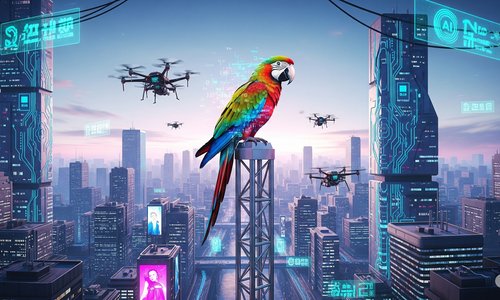
A Promessa e o Perigo da Nova Revolução Digital
A nova corrida tecnológica global levanta uma pergunta urgente: estamos prontos para confiar na inteligência que criamos?

A Inteligência Artificial Generativa tem se estabelecido como uma das tecnologias mais transformadoras da era digital, empregada em uma ampla variedade de setores, desde a criação de arte até o desenvolvimento de novos medicamentos. Estes modelos são capazes de gerar conteúdo altamente sofisticado, seja em texto, imagem ou som, a partir de vastos bancos de dados alimentados por contribuições humanas ao longo do tempo. Por meio do uso de redes neurais e algoritmos complexos, estas ferramentas conseguem replicar padrões, estilos e conceitos com uma eficiência que antes era impensável, tornando-se valiosas para empresas e criadores de conteúdo que buscam eficiência e inovação.
Os benefícios da IA Generativa são notáveis. No campo da publicidade, por exemplo, empresas utilizam essa tecnologia para gerar campanhas publicitárias personalizadas em escala, capazes de se adaptar às preferências de um público-alvo diversificado. No entretenimento, roteiros de filmes e músicas podem ser criados com a ajuda de inteligência artificial, proporcionando uma base criativa que pode ser refinada por artistas humanos. Além disso, em áreas como a pesquisa científica e a medicina, a capacidade de gerar modelos e combinações complexas facilita o desenvolvimento de novas terapias e medicamentos, acelerando o ciclo de inovação e potencialmente salvando vidas.
Contudo, a ampla adoção dessa tecnologia suscita preocupações significativas. A facilidade de geração de conteúdo pode levar a uma homogeneização cultural, onde ideias e expressões únicas são cada vez menos valorizadas em favor de fórmulas que garantem segurança e aceitação ampla. Esse fenômeno, que denominei “Efeito Baunilha”, destaca uma tendência preocupante em direção à uniformidade e à falta de diversidade criativa, à medida que as máquinas aprendem a replicar os padrões mais comuns e aceitos, potencialmente em detrimento da inovação genuína e da expressão individual.
Esse desafio nos leva ao cerne do Efeito Baunilha, um termo que criei para descrever a crescente homogeneização no conteúdo gerado por inteligência artificial. O fenômeno técnico conhecido como redução de dimensionalidade está no coração desse problema. Essencial para o funcionamento dos modelos de IA generativa, esse processo envolve a análise e aprendizado a partir de enormes conjuntos de dados, levando os modelos a identificar e replicar os padrões mais frequentes e dominantes. Isso geralmente favorece tendências comuns e amplamente aceitas, negligenciando nuances e variações menos comuns.
A técnica de aprendizado de máquina busca simplificar a complexidade para criar modelos operacionais em tempo real com recursos computacionais acessíveis. Essa simplificação muitas vezes resulta em uma preferência por 'caminhos' bem-sucedidos ou seguros, limitando a diversidade de saídas. Por exemplo, em ferramentas de criação de texto, frases e estruturas comuns nos dados de treinamento são replicadas com frequência, enquanto expressões únicas ou estilos idiossincráticos são raros.
Os efeitos práticos dessa redução são notáveis em contextos organizacionais e sociais, onde a dependência de conteúdos gerados por IA pode levar a comunicações e estratégias de marketing que, embora eficazes em atingir grandes audiências, falham em engajar ou ressoar em níveis mais profundos com públicos específicos. Isso pode resultar em campanhas que parecem genéricas ou despersonalizadas, potencialmente diminuindo a fidelidade e a confiança da marca.
Socialmente falando, a proliferação de conteúdos homogeneizados pode diminuir a riqueza da expressão cultural e criativa, estabelecendo um padrão onde novas ideias e vozes têm menos espaço para serem ouvidas e reconhecidas.
Diante desses desafios, uma reflexão mais profunda e a necessidade de agir tornam-se evidentes. À medida que contemplamos o futuro da Inteligência Artificial Generativa e seu impacto crescente na sociedade, é fundamental reconhecer os riscos associados à homogeneização criativa e cultural. Sem uma avaliação mais consciente deste fenômeno, a diversidade de pensamentos, expressões artísticas e inovações pode ser severamente limitada pelos contornos estreitos das tendências dominantes predefinidas por algoritmos.
Assim, o Efeito Baunilha não é apenas uma consequência técnica; é um desafio que precisa ser compreendido e gerenciado com cuidado por aqueles que desejam utilizar a IA generativa de maneira responsável e inovadora. A busca por equilíbrio entre eficiência e diversidade torna-se crucial para evitar a padronização excessiva e preservar o dinamismo e a inovação nas expressões humanas, sejam elas artísticas, comerciais ou comunicativas.
No entanto, existem estratégias proativas que podemos adotar para mitigar esses riscos e utilizar a IA generativa de maneira que enriqueça, em vez de diluir, a diversidade cultural e criativa. Uma das abordagens mais eficazes é o desenvolvimento e a utilização de prompts e contextos mais detalhados e especificamente desenhados. Ao fornecer aos modelos de IA descrições mais ricas e com mais nuances, podemos guiá-los para produzir resultados que reflitam uma gama mais ampla de possibilidades e minimizem a repetição de padrões genéricos.
Além disso, é crucial fomentar a interação entre a inteligência artificial e a criatividade dos humanos, utilizando a tecnologia como uma ferramenta que complementa e expande a capacidade humana, em vez de substituí-la. Isso pode ser realizado por meio de plataformas colaborativas onde humanos e máquinas co-criam, aproveitando a eficiência e a capacidade de processamento de dados da IA enquanto incorporam a intuição, o julgamento e a sensibilidade criativa características de humanos.
Outra medida importante é a implementação de políticas e regulamentações que incentivem a transparência nos modelos de treinamento de IA e promovam a inclusão de uma variedade mais ampla de dados. Isso ajudaria a garantir que as máquinas não apenas reproduzam as visões e vozes predominantes, mas também representem perspectivas sub-representadas e marginais. O mesmo vale para as organizações que podem criar modelos de IAs proprietários mais diversos, que representem a sua maneira de fazer negócios, com conteúdos e bases de dados únicos, e uma visão exclusiva e diferenciada de como elas se posicionam no mercado.
Em conclusão, enquanto a IA Generativa oferece oportunidades sem precedentes para inovação e eficiência, é nossa responsabilidade moldar seu desenvolvimento e uso de maneira que respeite e fomente a diversidade criativa e cultural. Com esforços conscientes para desenvolver prompts detalhados, colaboração entre humanos e máquinas, e políticas robustas, podemos dirigir o potencial da IA para um futuro em que a tecnologia amplie e enriqueça o complexo panorama da expressão humana, em vez de restringi-lo.
Conselheiro fundador da I2AI – Associação Internacional de Inteligência Artificial. Também é sócio-fundador da Engrama, sócio da Startup Egronn, e na consultoria Advance e investidor na startup Agrointeli . Tem mais de 20 anos de experiência em multinacionais como Siemens, Eaton e Voith, com vivência em países e culturas tão diversas como Estados Unidos, Alemanha e China.
Palestrante internacional, professor, pesquisador, autor, empreendedor serial, e amante de tecnologia. É apaixonado pelo os temas de Estratégia, Inteligência Competitiva e Inovação.
É Doutor em Gestão da Inovação e Mestre em Redes Bayesianas (abordagem de IA) pela FEA-USP. É pós-graduado em Administração pela FGV e graduado em Engenharia Mecânica pela Unicamp.

A nova corrida tecnológica global levanta uma pergunta urgente: estamos prontos para confiar na inteligência que criamos?

Por que dominar a IA será a nova alfabetização do século XXI

Conselhos de Administração devem evoluir da supervisão reativa para a antecipação estratégica, frente à crescente complexidade e volatilidade dos ambientes de negócios.

De 14 a 25 de julho, reserve suas manhãs das 08h00 às 09h30 para participar da tradicional Maratona I2AI! Uma jornada intensa com debates e palestras sobre temas essenciais: Ética,